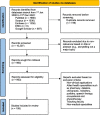The role of patients' stories in medicine: a systematic scoping review
- PMID: 38087237
- PMCID: PMC10714554
- DOI: 10.1186/s12904-023-01319-w
The role of patients' stories in medicine: a systematic scoping review
Abstract
Background: Patients' stories provide Palliative Care physicians with a glimpse into the former's lives and their psycho-emotional, sociocultural, and contextual considerations. Yet, few physicians are trained to interpret and apply patients' stories in their practice. Inherent variability in how stories are transmitted and interpreted raises questions over their potential effects on care. Amidst a dearth of accounts in Palliative Care, we map current use of patient stories to guide the training, assessment, and oversight of this 'care influencing' practice in medicine.
Methods: This systematic scoping review was guided by the Systematic Evidence-Based Approach (SEBA) to ensure a reproducible and structured approach. The themes and categories identified through the Split Approach's concurrent and independent thematic and directed content analyses provided a comprehensive sketch of the included articles. The Jigsaw Perspective combined the themes and categories identified. The last stage of SEBA compared these results with two recent reviews of storytelling to ensure consistency of the domains created that guided the discussion.
Results: Ten thousand two hundred seven articles were reviewed, 963 full text articles were evaluated, and 199 articles were included. The four domains identified were study characteristics, benefits, approaches, and positive effects and concerns.
Conclusion: Stories support patient-centered, personalized, and holistic clinical care. However, variability in the stories, their interpretations and use in care decisions underscore the need for further study on the structuring, teaching, assessing, and delivery of this 'care influencing' practice.
Keywords: Care determination; Narratives; Palliative Care; Patient centered care; Physicians; Professional identity formation; Storytelling.
© 2023. The Author(s).
Conflict of interest statement
The authors declare no competing interests.
Figures
References
-
- Youell J, Ward A. Why use storytelling in palliative care? : ehospice; 2016. Available from: https://ehospice.com/uk_posts/why-use-storytelling-in-palliative-care/.
-
- Forbes K. Narrative and storytelling in palliative care education and training. 2009. In: Narrative and Stories in Health Care: Illness, dying and bereavement. Oxford University Press. p. 111–26. Available from: 10.1093/acprof:oso/9780199546695.003.0008. Cited 3/24/2023.
Publication types
MeSH terms
LinkOut - more resources
Full Text Sources
Medical



